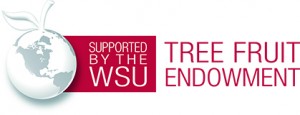The production of apples is a complex process involving orchard management, storage, and marketing phases. Technology makes the long-term storage of fruit possible, and in Washington State, apples can be stored for up to 12 months. Postharvest diseases can be a limiting factor to long-term storage though, with fruit decay and repacking due to disease costing the fruit industry millions of dollars in losses each year. Some Postharvest diseases originate from infection in the orchard (Sphaeropsis rot caused by Sphaeropsis pyriputrescens, Phacidiopycnis rot caused by Potebniamyces pyri, and Bull’s eye rot caused by Neofabraea spp.); and some are associated with postharvest handling processes (Blue mold caused by Penicillium spp., mainly P. expansum, Gray Mold (Botrytis cinerea), and Mucor rot caused by Mucor piriformis). Postharvest parasitic diseases of apples in the Pacific Northwest are predominantly caused by fungi.
The control of postharvest decay begins in the orchard with orchard floor sanitation, fungicide applications, and insect control, and continues with careful fruit handling practices before and during cold storage until fruit are sold. Strategies to control fungal diseases of apple are of major concern to warehouse managers. WSU researchers are conducting studies on postharvest diseases in two phases: 1) fruit decay in storage bins before packing and 2) fruit decay after packing. Accurate diagnosis of postharvest diseases is the first step to implement relevant measures to control the problems. Learn more » Links to Tree Fruit Market Diseases.
WSU’s postharvest information network is a source for information on apples, and post-harvest practices. Go to the Postharvest Information Network home page.
Cullage Assessment
With a keen eye on the needs of Washington producers selling to the global market, WSU researchers have trainings and information to help industry professionals identify damage and disorders encountered during the cullage assessment phase of the post-harvest process. There are also useful materials for people involved with identification of fruit damage in the orchard. Available materials include visual identification guides, instructions for sampling in the orchard and packinghouse, as well as, quarantine pest and export work plan information. Learn more »
Resources:
Videos
Fact Sheets
- Guidelines for control of speck rot in apples, a WSU and USDA-ARS collaborative fact sheet.
- Guidelines for control of Sphaeropsis rot in apples, a WSU and USDA-ARS collaborative fact sheet.
- Guidelines on pruning Manchurian crabapple for fruit rot control, a WSU, USDA-ARS, and Pace Int. collaborative fact sheet.
Trade Articles
- Research is vital to keep Asian apple export markets open, D. Layne, Growing Produce, July, 2015.
- Research on rot is underway, G. Warner, Good Fruit Grower, February, 2015.
- Research tackles decay issue, G. Warner, Good Fruit Grower, October, 2014.
Technical Articles
- Development of PCR assays for diagnosis and detection of the pathogens Phacidiopycnis washingtonensis and Sphaeropsis pyriputrescens in apple fruit, P. Sikdar, et al., Plant Disease, 98(2): 241-246, February, 2014.
- Sources and availability of inoculum and seasonal survival of Sphaeropsis pyriputrescens in apple orchards, C.L. Xiao, Plant Disease, 98(8):1043-1049, August, 2014.
- Preharvest applications of fungicides for control of Sphaeropsis rot in stored apples, Y. K. Kim and C. L. Xiao, Plant Management Network, 2013.
